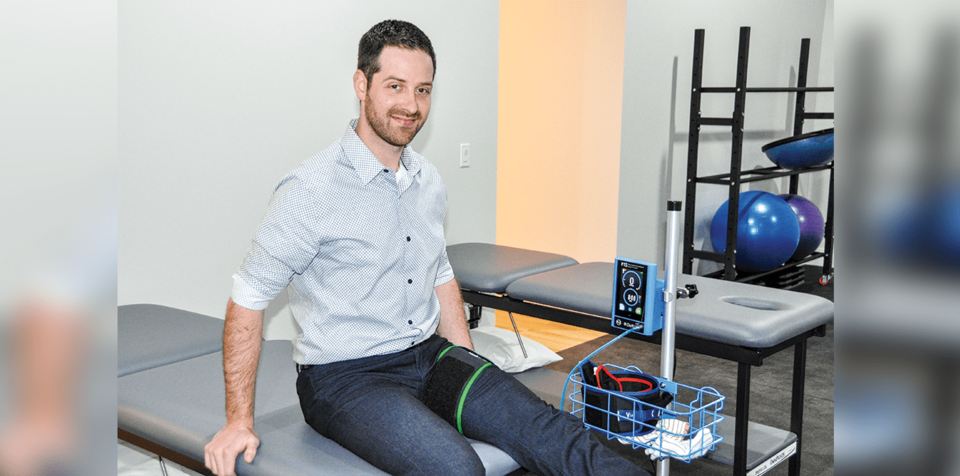Ryan Walker, the physiotherapist/owner of Niagara Orthopedic Institute in Fonthill, is in the pain business.
His clients are young and old, athletic and sedentary, all eager to rehabilitate their joints and muscles due to injury, or deterioration with age. And pain is an unfortunate consequence.
Walker offers a broad range of treatments, but the one he is currently most excited about is blood flow restriction therapy (BFR). His is one of the few clinics in Ontario currently offering the procedure, and Walker himself is one of fewer than a dozen certified practitioners in all of Canada.
BFR involves brief and intermittent occlusion of blood flow of a limb using a tourniquet—in this case, a pneumatic cuff, not unlike an inflatable blood pressure cuff. Both arterial blood flow (from the heart) and venous blood flow (to the heart) are restricted. Light-load exercise is performed while the cuff is inflated, with potential gains in muscle mass and strength comparable to those of heavy resistance training. The treatment has post-operative and post-injury applications.
“Right now I have about four clients on BFR. A couple are competitive athletes, one's a post-operative patient, and one's an older woman with an arthritic knee,” said Walker.
Developed in Japan in the 1970s, the treatment gained attention about 20 years ago when an American army physical therapist used the technique to build muscle strength in soldiers, especially those who had been injured in battle. Bodybuilders have also employed blood flow restriction in their training by tightly wrapping their knees and elbows as part of their weight lifting regimen.
BFR therapy is not yet widely prescribed by doctors, but Walker says research increasingly shows that it is a safe and effective way to improve strength and cardiovascular function, especially in older people who are unable to tolerate traditional strength or endurance training. Walker stresses that this treatment is not experimental, having undergone rigorous random control trials worldwide, with plenty of scientific data supporting its effectiveness.
“The awareness of BFR just isn't there yet…most surgeons have no familiarity with it. It's a big unknown in Canada. I was planning to get out to speak with local health care professionals about BFR, but COVID put a damper on that,” he said.
Walker considers it especially noteworthy that studies have indicated BFR encourages the release of chemical mediators like endorphins (one of the “feel-good” hormones) that relieve pain.
It’s one of the biggest breakthroughs in the field in the past 20 years
Although many studies have reported positive results from BFR, some medical professionals advise against the unsupervised use of the therapy. If performed improperly, BFR has the potential to cause a thrombosis (blood clot) or nerve damage.
“Nerve damage is probably the most real concern with this, and that's mitigated in a couple ways,” said Walker. “We use a wide pneumatic cuff, which distributes the pressure over a larger surface area. In addition, our unit has a Doppler ultrasound feature, which adjusts the cuff pressure to each unique patient.”
The potential risk of a thrombosis is very low, said Walker, since the inflated cuff is only activated for about eight minutes at once, which allows the body plenty of time to restore its normal blood flow to the limb. By comparison, tourniquets applied during medical operations restrict blood flow for much longer periods.
Asked about frequency of treatment and costs, Walker said “I would recommend two sessions a week for at least four weeks to see positive results. Patients require an initial assessment ($85) to see if BFR is right for them, with follow-up sessions ($70) lasting about 30-45 minutes per session.”
“BFR really is a game changer when it comes to rehab therapy,” said Walker. “It’s one of the biggest breakthroughs in the field in the past 20 years.”



